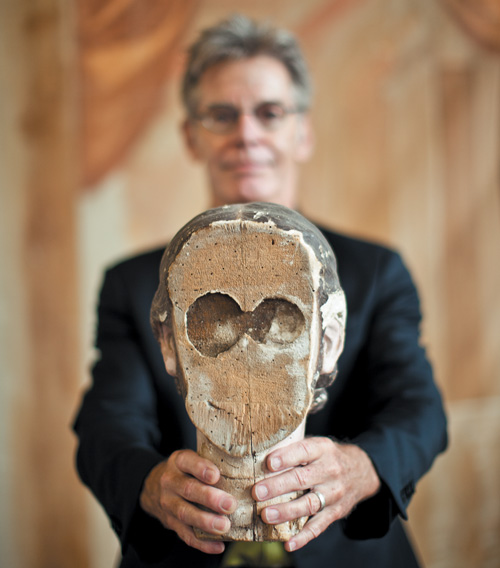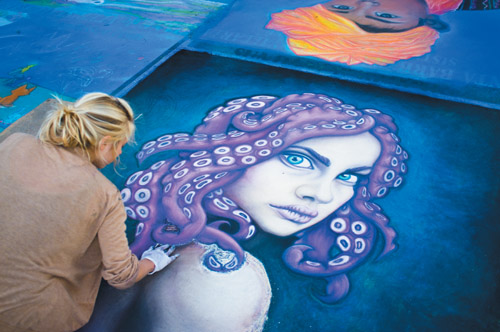27. Eclectic and Eccentric

Just before I took this picture of Keith Carter holding a faceless religious statue head, I was reading a few handwritten quotes on the walls of his darkroom. “Try to make pictures that are wise rather than clever.” “Life for a photographer cannot be a matter of indifference.” This portrait is a small attempt to make some of those words come alive.
Canon 5DMii, 50mm lens, f/1.2
IN THE CURRENT global economy, mass production is king. Profit is defined by volume and how quickly something can be made. By using cookie-cutter and carbon-copy techniques, we’ve invented a cycle of production that feeds off the ability to replicate. The result is a lot of perhaps high-quality goods, yet so much of life looks the same. You can walk into a brand X coffee shop anywhere in the world and not really know where you are. And everyone, even some photographers, is now catching on to this cycle.
I think that is why I like things that are handmade—my young daughters’ drawings, pencil-written notes, and the old driftwood gate in our backyard. There is something special about those things that cannot be mass-produced. This is one of the reasons I make pictures. As photographers, we aren’t technicians who repeatedly follow the same steps. We make our own path. We are driven to create something that is one of a kind. We want to express our unique voice and vision. It is something we have to do. Taking pictures satisfies an internal thirst—it is an essential part of who we are.
Sustaining this inner drive requires resisting the urge to quickly impersonate. True artistic creativity requires a more eclectic approach. The eclectic artist derives ideas, style, and inspiration from a broad range of unlikely sources. Rather than following the flow of the latest popular trend, the eclectic photographer strikes out on his own path. And this path has no end. It’s a journey that lasts a lifetime.
Turning the Page
The painter Robert Henri wrote in his book The Art Spirit, “When the artist is alive in any person, whatever kind of work it may be, he becomes an inventive, searching, daring, self-expressive, and self-expressing creature. He becomes interesting to other people. He disturbs, upsets, enlightens, and opens ways for a better understanding. Where those who are not artists are trying to close the book, he opens it and shows that there are more pages possible.”
Vibrant and growing artists find possibility around every bend. Eccentric artists take that to a whole new degree. Rather than opening a book, they invent a new world. They come up with unrealistic and unconventional ideas like Cubism or a Disneyland theme park. The eccentrics are those who operate on the fringe. They turn logic on its head. They have no comfort zone.

An artist completes her sidewalk chalk drawing, which took her 15 hours and will only last a few weeks—part of the beauty of this temporal and impressive piece.
Fuji FinePix X100, 35mm lens, f/2
Exercise: One-of-a-Kind People
Creative inspiration can be found in the typical ways—folk music, literature, or independent films. Or you can go straight to the source. Spend some time with an eccentric person, whether a butterfly collector, sidewalk chalk artist, or someone who custom-paints cars, and you will be inspired in a whole new way. For this exercise that is exactly what I want you to do. Why? Because you can never underestimate the power of finding inspiration from an eclectic source.
Step 1 Choosing a Level of Eccentricity
Eccentricity ranges from the peculiar to the legitimately insane. Choosing how deep you want to go is completely up to you. For starters, you might pick someone to photograph who goes just slightly against the tide. Whoever you choose, make sure she fits the requirement of truly being one-of-a-kind.
Maybe you know an architect who refuses to use computers and draws everything by hand. Or perhaps you have a business acquaintance who constantly dreams up off-the-wall entrepreneurial ideas. Then there is the ubiquitous “cat lady” who lives at the end of your street. Of course, you can always go more extreme. Trust your gut and reach out to an eccentric person and ask if you can meet for 30 minutes to create her portrait and to learn more about her life. Ask if you can photograph the subject in her home, studio, or workspace.
Tips
Don’t worry about the photographic results and don’t impose any preconceived ideas. Watch, wait, and listen. Let the eclectic subject lead the way. Take pictures as the conversation unfolds.
If you start having trouble connecting with the subject, ask about how she started out or what inspires her most.
In order to create photographs that say something, try this: Imagine that the pictures are for a documentary about this person’s life.
Step 2 Preshoot Planning?
From a distance, the eccentric can seem unscheduled, erratic, and completely untamed. In the face of such uncertainty, it might seem like a good idea to go into the photo shoot with a plan. Here’s what I suggest. Throw your agenda out the window. Preshoot planning—don’t do it. Get out your camera bag, pack every type of lens that you own, and go for it.
Step 3 Photo Shoot
Every person has a story, and every story can teach you something. Let your guard down and approach the subject with an authentic enthusiasm for who she is and what she does. Often, eccentric people are marginalized and don’t have an avenue for sharing their voice. Ask them questions and provide them with an opportunity for sharing what means the most. As they talk, take pictures in between.
Exercise Details
Goal: 25 portraits of an eccentric subject. Tools: Camera, lenses—try everything from fish-eye to telephoto. Light: Natural or available light. Location: Subject’s home. Theme: Inspiration from eccentric people. Duration: 30 to 60 minutes.
Near the end of the meeting (at about 20 minutes) ask if you can arrange a couple of shots. Have the subject stand in a few particular spots. Give her feedback that she is doing just fine. Explain that you want a photograph that captures her personality and not some preconceived idea. Wrap the shoot and say good-bye.

ABOVE Charles is an eccentric artist, who lives completely off the grid. This is a impressive room inside his house he built alone from concrete and glass bottles.
Canon 5DMii, 16–35mm lens, f/2.8
Step 4 Journal
Immediately after the photo shoot, go to a coffee shop with journal in hand. Sit down for 10 to 15 minutes and record your thoughts. What did you learn? How did this person affect the way that you see? While you may not want to become as eccentric as your subject is, perhaps she has a new way of thinking that you might integrate to a lesser degree.
Step 5 Share
Make prints of your favorite pictures and share the experience with another colleague or friend.
OPPOSITE With this artist I noticed a unique sculpture hanging in the corner of the garage. Rather than photograph it in the garage, I asked if he wouldn’t mind carrying the piece out into the street. The out-of-place sculpture seemed to work better there, bringing out the strangeness of the piece that became even more pronounced.
Canon 5DMii, 50mm lens, f/2.8
“A photograph is a secret about a secret. The more it tells you the less you know.”
—Diane Arbus

